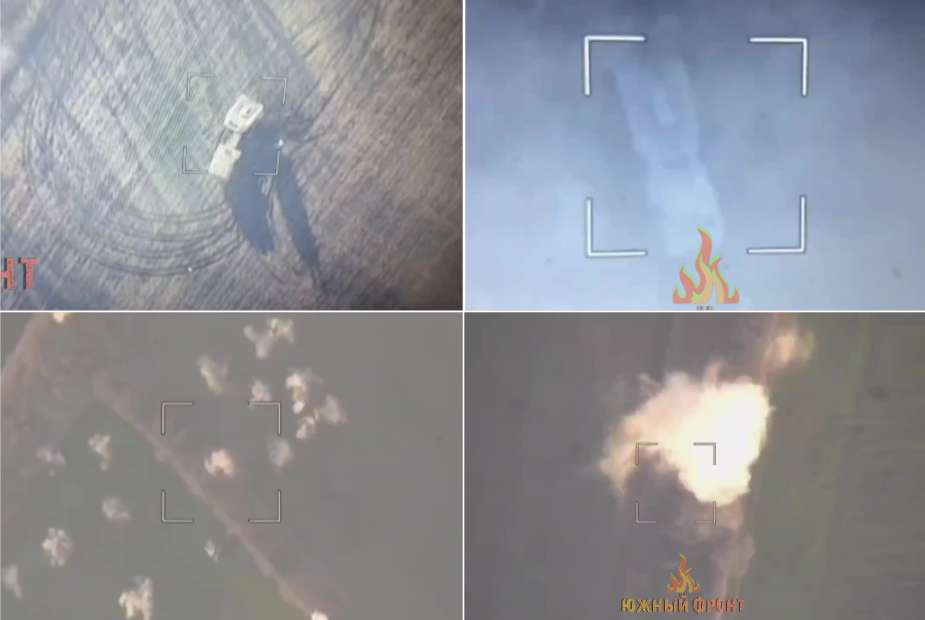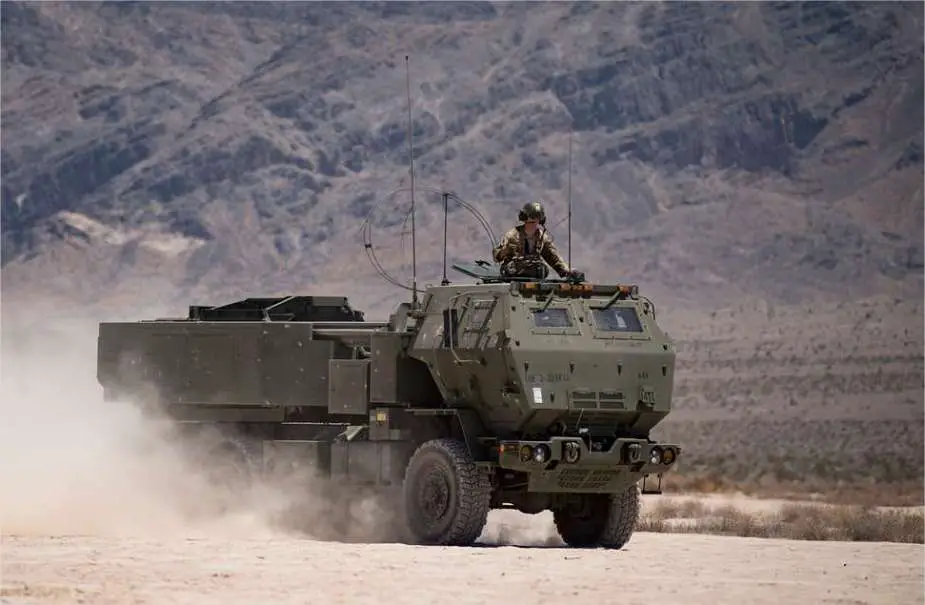On January 1, 2023, the Russian Southern Front Telegram channel released footage showing the apparent destruction of an M142 HIMARS (High Mobility Artillery Rocket System) belonging to the Ukrainian Armed Forces. This video could mark the first documented instance of a US-supplied HIMARS MLRS (Multiple Launch Rocket System) being destroyed since the beginning of the Russian invasion in 2022.
Follow Army Recognition on Google News at this link

Ukrainian HIMARS system tracked by a Russian drone, subsequently targeted with cluster munitions, resulting in visible smoke plumes, indicating potential damage or destruction of the M142 HIMARS. (Picture source: Telegram)
The incident occurred in eastern Ukraine, approximately 8 kilometers south of Kostiantynivka village in Donetsk Oblast. The Ukrainian HIMARS system was discovered by reconnaissance soldiers from the Russian "Yuzhny" unit shortly after the US system had fired its rockets.
Subsequently, a drone was employed to track the HIMARS' location, and once it became stationary, the system was targeted with cluster munitions. The visible plumes of smoke captured in this footage suggest that the M142 HIMARS may have suffered significant damage or even total destruction.
Among Russian soldiers, the M142 HIMARS rocket launcher is considered as one of the most dangerous types of weapons supplied by the United States to Ukraine, as it has played a role in enhancing the capabilities of the Ukrainian Armed Forces. The destruction of the HIMARS is therefore noteworthy due to the role this U.S.-supplied rocket system has played in enhancing the capabilities and effectiveness of the Ukrainian military during the ongoing conflict with Russia.
The HIMARS system's strategic advantages include the capability to engage targets at distances of up to 300 kilometers. This range is relevant for targeting various Russian assets, including command posts, fuel and ammunition depots, large concentrations of Russian forces, warehouses, and other static positions located beyond the reach of Russia's defense systems. On the battlefield, this also includes critical military assets used by Russian forces, such as long-range artillery systems like the 2S7 Pion, BM-27 Uragan, and 2S19 Msta-S, electronic warfare systems like the Leer-2, radar systems such as Zoopark-1, and air defense systems including Buk-M1, and Buk-M3. This capability has enabled Ukraine to have a significant impact on the Russian forces' ability to conduct operations on the front line.
The introduction of HIMARS has enabled the Ukrainian military to shift from attritional warfare, which had been a focus in the Donbas region, to asymmetric tactics that target Russian weaknesses by engaging Russian targets in areas previously inaccessible due to Russian air defense systems. This includes striking crucial railway-based logistics hubs, as well as artillery and military personnel concentration areas of the Russian forces. For instance, more than a dozen major Russian supply depots, primarily used to store artillery ammunition, have been attacked with HIMARS rockets.

Among Russian soldiers, the M142 HIMARS rocket launcher is considered as one of the most dangerous types of weapons supplied by the United States to Ukraine. (Picture source: US DoD)
The precision-guided munitions of HIMARS have been instrumental in minimizing collateral damage, especially in attacks near civilian areas. Many Russian supply depots are located close to civilian towns, and the precision of HIMARS enables targeted attacks that reduce unintended harm to nearby civilian structures.
The use of HIMARS has also had a psychological effect on Russian forces. With a greater proportion of Russian forces now falling within the attack radius of HIMARS, the psychological toll on Russian military personnel, particularly those working in ammunition and logistic depots, has been significant. This psychological aspect can affect the overall effectiveness and morale of the military organization within the Russian Army in Ukraine.
Moreover, its high mobility, "shoot and scoot" feature, and agility allow for swift relocation after firing on the battlefield, making it challenging to detect while reducing the risk of counterattacks.
Finally, the introduction of the M142 HIMARS into the Ukrainian arsenal has substantially influenced the dynamics of the conflict. For instance, it played a role in Ukraine's rapid advance around Kharkiv, aiding in the destruction of Russian positions and depots and enabling Ukrainian forces to reclaim significant territories. Additionally, the timely deployment of HIMARS units in Ukraine has been a key factor in maintaining the country's defensive lines and positions. This stabilization is crucial in a conflict where territorial control and defensive capabilities are constantly being challenged.
Developed by Lockheed Martin for the United States Army, the M142 HIMARS is noted for its mobility, precision, and versatility. Its lightweight, wheeled design facilitates rapid deployment and transportation by aircraft, adding to its operational flexibility. Capable of employing various munitions, including the Guided Multiple Launch Rocket System (GMLRS) and the Army Tactical Missile System (ATACMS), the M142 HIMARS can engage targets up to 300 km away. The M30 GMLRS, as the primary munition for HIMARS, employs GPS guidance for high accuracy, with a circular error probable (CEP) of less than 5 meters under optimal conditions. Furthermore, the introduction of the Precision Strike Missile (PrSM), with an extended range of approximately 500 kilometers, could potentially enhance the defensive capabilities of regional allies if supplied.















